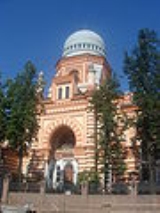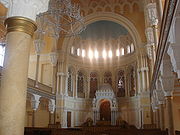
Grand Choral Synagogue
Encyclopedia

Synagogue
A synagogue is a Jewish house of prayer. This use of the Greek term synagogue originates in the Septuagint where it sometimes translates the Hebrew word for assembly, kahal...
in Europe. It was built between 1880 and 1888, and consecrated in 1893. Poet Osip Mandelstam
Osip Mandelstam
Osip Emilyevich Mandelstam was a Russian poet and essayist who lived in Russia during and after its revolution and the rise of the Soviet Union. He was one of the foremost members of the Acmeist school of poets...
called the Petersburg Synagogue a "lavish, outstandish seductress".
Permit from the Tsar
The St. Petersburg Synagogue could be built only after the building permit was obtained on September 1, 1869 from Tsar Alexander IIAlexander II of Russia
Alexander II , also known as Alexander the Liberator was the Emperor of the Russian Empire from 3 March 1855 until his assassination in 1881...
, who lessened the restrictions for Jews' residence in St. Petersburg. This became possible after the memorandum to the Royal Name was submitted by the leader of the Jewish Community, Hereditary Honorary Citizen of Russia Evzel Ginzburg, who was one of the major suppliers of the Russian Imperial Army. His son, Horace Evselevich Ginzburg, was Chairman of St. Petersburg Jewish community in 1869 - 1909, and supervised the construction of the first synagogue in St. Petersburg.
Tsar Alexander II allowed Jews who were retired soldiers, people with academic degrees, 1st guild merchants, specialty craftsmen, and technicians to reside in St. Petersburg, as well as other cities outside the Pale of Settlement
Pale of Settlement
The Pale of Settlement was the term given to a region of Imperial Russia, in which permanent residency by Jews was allowed, and beyond which Jewish permanent residency was generally prohibited...
. By 1870, there were about ten Jewish houses of worship in St. Petersburg, however, there was no Grand Synagogue to serve the entire Jewish community in the Russian capital.
The land plot for the first synagogue was bought in 1879 for 65,000 rubles. The construction of the first synagogue in St. Petersburg was subject to multiple conditions and restrictions. For example, there could be no Christian churches near the synagogue, nor government roads used by the Tsars. Another restriction was the height of the building, which was limited to 47 meters, instead of the 65 meters proposed by the architects. In fact, no building in St. Petersburg could be higher than 23 meters, the height of the Tsar's Winter Palace
Winter Palace
The Winter Palace in Saint Petersburg, Russia, was, from 1732 to 1917, the official residence of the Russian monarchs. Situated between the Palace Embankment and the Palace Square, adjacent to the site of Peter the Great's original Winter Palace, the present and fourth Winter Palace was built and...
, and exemptions were only given for bell towers and domes, because those also served as observation towers for fire watch and other safety purposes. While allowing the synagogue to be 47 meters tall, the Tsar imposed several other requirements.
"His Majesty, noting that a more modest appearance befits the building of the first synagogue in the capital, according to the civic standing of Jews in our homeland, gives the Tsar's permission for building the synagogue."
Architecture

.jpg)
.jpg)
Moorish Revival
Moorish Revival or Neo-Moorish is one of the exotic revival architectural styles that were adopted by architects of Europe and the Americas in the wake of the Romanticist fascination with all things oriental...
for its design, modeled in part after Berlin's Oranienburgerstrasse Synagogue
New Synagogue
The Neue Synagoge was built 1859–1866 as the main synagogue of the Berlin Jewish community, on Oranienburger Straße. Because of its splendid eastern Moorish style and resemblance to the Alhambra, it is an important architectural monument of the second half of the 19th century in Berlin.The...
with its melange of Moorish and Byzantine motifs. In the end, the project boasted an eclectic blend of neo-Byzantine and Moorish revival styles with Arabesque motifs, upon the request of V. V. Stasov, the influential Russian art critic and supervisor of the project. The Great Choral Synagogue was designed by architects I.I. Shaposhnikov, L. Bakhman, and V.A. Shreter, with the participation of V. V. Stasov and N. L. Benois
Nicholas Benois
Nicholas Benois was a Russian architect who worked in Peterhof and other suburbs of St Petersburg.Benois was born of French parents in Russia and studied at the Imperial Academy of Arts from 1827 to 1836...
, who was the curator of the project and the confidant of the Tsar and the Russian government.
The land for the synagogue was allocated near the Mariinsky Theatre
Mariinsky Theatre
The Mariinsky Theatre is a historic theatre of opera and ballet in Saint Petersburg, Russia. Opened in 1860, it became the preeminent music theatre of late 19th century Russia, where many of the stage masterpieces of Tchaikovsky, Mussorgsky, and Rimsky-Korsakov received their premieres. The...
. The construction was carried out under the management of the Construction Committee headed by A.A. Kaufman. The architect and superintendent of construction was A.V. Malov, and his assistants were S.O. Klein and B.I. Girshovich, between 1880 and 1888. First, the Small Synagogue was opened in 1886. The Great Choral Synagogue was consecrated in 1893.
During the First World War
The 100-bed hospital for the wounded of all confessions was organised by the Jewish community of St. Petersburg on the premises of the synagogue. The building of the YeshivaYeshiva
Yeshiva is a Jewish educational institution that focuses on the study of traditional religious texts, primarily the Talmud and Torah study. Study is usually done through daily shiurim and in study pairs called chavrutas...
near the Great Choral Synagogue had also served as a medical facility for many years.
Synagogue in the Soviet era
After the 1917 revolution and the following Russian Civil WarRussian Civil War
The Russian Civil War was a multi-party war that occurred within the former Russian Empire after the Russian provisional government collapsed to the Soviets, under the domination of the Bolshevik party. Soviet forces first assumed power in Petrograd The Russian Civil War (1917–1923) was a...
, the Jewish community of St. Petersburg had lost many members due to emigration. The Soviet authorities imposed restriction on bank accounts related to the synagogue, and also announced the dissolution of the Jewish community of St. Petersburg, by the decree signed by Grigory Zinoviev
Grigory Zinoviev
Grigory Yevseevich Zinoviev , born Ovsei-Gershon Aronovich Radomyslsky Apfelbaum , was a Bolshevik revolutionary and a Soviet Communist politician...
.
Rabbi Yosef Yitzchak Schneersohn, sixth Grand Rabbi of Chabad-Lubavitch
Chabad-Lubavitch
Chabad-Lubavitch is a Chasidic movement in Orthodox Judaism. One of the world's larger and best-known Chasidic movements, its official headquarters is in the Crown Heights section of Brooklyn, New York...
, made Leningrad his place of residence in 1924 - 1927, together with his circle of friends and supporters. Communists were initially seeking collaboration with such an influential religious leader, however their attempts failed. In 1927, Rabbi Schneersohn was arrested by the Soviet political police, and was imprisoned in the Shpalernaya prison under the false accusations of anti-Soviet activity, that would lead to a death penalty. The international public uproar forced the Soviets to substitute the death penalty by exile to Kostroma, and later Rabbi Schneersohn was released and emigrated.
During the Second World War
The St. Petersburg Synagogue was bombed by the Nazis during the Siege of LeningradSiege of Leningrad
The Siege of Leningrad, also known as the Leningrad Blockade was a prolonged military operation resulting from the failure of the German Army Group North to capture Leningrad, now known as Saint Petersburg, in the Eastern Front theatre of World War II. It started on 8 September 1941, when the last...
between 1941 and 1943. However, the hospital on the premises of the synagogue was in operation. The Jewish community managed to survive the siege of Leningrad, as well as other oppression over the years.
National landmark
Today the Great Choral Synagogue of St. Petersburg is a registered landmark and an architectural monument of federal importance. Major reconstruction was carried out between 2000 and 2003. On 5 Tamuz 5761 (June 26, 2001), the greater hall was reopened after reconstruction. The greater hall, also called the main hall, holds 1200 and has women's galleries on three sides.Reconstruction and renaming
After the 5 million dollar donation by the Safra family in 1999, the reconstruction of the Grand Choral Synagogue of St. Petersburg was made between 2000 and 2005. Upon conditions of the donation the St. Petersburg Synagogue was renamed The Edmond J Safra Grand Choral Synagogue, although the community still calls it in Russian Bolshaya Sinagoga.In 2005 a new Mikvah
Mikvah
Mikveh is a bath used for the purpose of ritual immersion in Judaism...
was built from a design by Israeli architect M. Gorelik. The new Mikvah in the Grand Choral Synagogue was inaugurated on April 19, 2005.
The Chief Rabbi of St. Petersburg is Menachem Mendel Pewzner.
The Grand Choral Synagogue of St. Petersburg is located at 2 Lermontovskii Prospekt, St. Petersburg, Russia.
Jewish cemetery of St. Petersburg
Since 1802 the Jews of St. Petersburg received a piece of land to bury their dead, however it was a strip of land near the Lutheran part of the Volkovo CemeteryVolkovo Cemetery
The Volkovo Cemetery , is one of the largest and oldest non- Orthodox cemeteries in Saint Petersburg, Russia. Until the early 20th century it was one of the main burial grounds for Lutheran Germans in Russia...
.
On December 1, 1872, a Jewish cemetery was founded on the land south of the city, in Obukhovo
Obukhovo
Obukhovo is an urban locality in Noginsky District of Moscow Oblast, Russia, located east from Moscow. Population: -Overview:The settlement is divided into two parts by the M7 auto route....
. A synagogue was erected at the entrance to the Jewish cemetery of St. Petersburg.
Grand Choral Synagogue of St. Petersburg name variants
- Grand Choral Synagogue of St. Petersburg - is the traditional official name for this synagogue in English.
- Great Choral Synagogue of St. Petersburg - is a name variant for this synagogue in English.
- The Edmond J Safra Grand Choral Synagogue - is the new name (after 2000) in English.
- Bolshaya Sinagoga (in Russian) - is the Russian language name for this synagogue.

